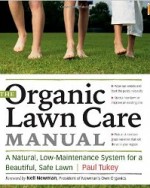 The passion for a beautiful lawn is nothing new, going back to at least the early nineteenth century, but the concept of having a beautiful lawn without using chemicals is just coming of age. Paul Tukey’s book, The Organic Lawn Care Manual offers a new approach to natural lawn care that can satisfy the desire for a lush green turf in a responsible way that in the long run is cheaper and requires less maintenance than traditional methods. What’s more, as Tukey points out, an organic lawn is safer for pets and children and some day we will wonder why we didn’t abandon lawn chemicals long ago.
The passion for a beautiful lawn is nothing new, going back to at least the early nineteenth century, but the concept of having a beautiful lawn without using chemicals is just coming of age. Paul Tukey’s book, The Organic Lawn Care Manual offers a new approach to natural lawn care that can satisfy the desire for a lush green turf in a responsible way that in the long run is cheaper and requires less maintenance than traditional methods. What’s more, as Tukey points out, an organic lawn is safer for pets and children and some day we will wonder why we didn’t abandon lawn chemicals long ago.
Tukey takes the reader through the steps of establishing and maintaining an organic lawn. His approach is simple and involves treating the soil well with compost and natural fertilizers, selecting a grass cultivar suitable for the site, water appropriately, and mow properly with a sharp blade. Each of these steps is discussed in detail with lots of background information and illustrations to develop the ideas. Highlighted inserts provide additional information for those interested so you learn about such things as endophytes (beneficial fungi in grass), nitrogen fixation, and the difference between cultivar and variety. A chapter on grasses explains the different kinds of grass that are available for different climates and situations (like shade), while another provides instructions for establishing a lawn from scratch in twelve steps and includes a nifty chart showing the advantages and disadvantages of seeding vs sodding. Renovating and patching an established lawn are also covered. Separate chapters treat the best ways to feed and care for a lawn including directions for making compost tea, strategies for determining and supplying water needs, and dealing with weeds, including determining what the weeds are telling us about the soil. A similar approach is presented to deal with pests and diseases. In the chapter on mowing Tukey explains how to mow properly but also includes suggestions for selecting a good lawn contractor if you don’t want to do the mowing yourself. The final chapter deals with alternative ways to handle areas that are considered undesirable for lawns and includes information on rain gardens, ground covers, xeriscaping, and low-mow grass alternatives. An appendix on games for lawns, a glossary, and a recommended reading list conclude the work.
Tukey makes a strong case for organic lawn care and provides a wealth of information on how to go about doing so. If a beautiful lawn is a priority for you, this book will tell you how to get it in an environmentally safe way. The procedures described are no harder than traditional ones but they may be more effort than the average homeowner wants to put into it. Having a nice lawn takes effort and can be done with lots of chemicals and water or without them. Tukey gives the reader a choice that is economically and environmentally better and results in less maintenance in the long run.
To buy The Organic Lawn Care Manual: A Natural, Low-Maintenance System for a Beautiful, Safe Lawn from Amazon.com click here.